Artemisia Essential Oil (AEO) Could Bring Autonomic Nervous Activity and Anxiety Behavior Changes?
Renka Maeda1, Wenping Zhang2, Masaki Tsukahara3, Hirotaka Oikawa3 and Takahiko Fujikawa3
1Graduate School of Health Science, Suzuka University of Medical Science, Japan
2Department of Acupuncture and Moxibustion, Suzuka University of Medical Science, Japan
3Department of Pharmaceutical Science, Suzuka University of Medical Science, Japan
Submission:November 21, 2023;Published:November 28, 2023
*Corresponding author:Wenping Zhang, Department of Acupuncture and Moxibustion Suzuka University of Medical Science1001-1, Kishioka, Suzuka, Mie, Japan, Email: zwp2000@suzuka-u.ac.jp
How to cite this article: Renka M, Wenping Z, Masaki T, Hirotaka O, Takahiko F. Artemisia Essential Oil (AEO) Could Bring Autonomic Nervous Activity and Anxiety Behavior Changes?. J Complement Med Alt Healthcare. 2023; 12(4): 555842. DOI: 10.19080/JCMAH.2023.12.555842
Abstract
In recent years, under the surroundings of a rising serious problem of stress-related depression and other psychiatric disorders, stress-improving and anti-anxiety effects of acupuncture, moxibustion and aromatherapy are attracting attention. In this study, we investigated anti-anxiety effects of Artemisia essential oil (AEO) on highly anxious and uneasy rats using parameters such as autonomic nerve activities LFnu, HFnu, behaviors, and open-field test et al. After 14 times of AEO intervention, decreased LFnu combined with a trend of longer resting time, a following raising activity will and sleeping conduction actions were found. In addition, a higher tension of jejunum and ileum as well as the significantly longer time before ileum being sharp than CONT rats were also shown. From these results, we conclude that the continuous intervention of the mugwort essential oil might fix the balance of the autonomic nerve activity and metabolism and would possibly provide an alternative therapy to relieve the symptoms such as anxiety, uneasiness, sleep disorder, willingness, and a digestive organ disease in conjunction with the stress.
Keywords: Mug Wort; Aroma; Antianxiety Effect; Autonomic Nerve Activity; Rat
Abbreviations: WHO: World Health Organization (WHO; AEO: Artemisia essential oil (AEO); ANS: autonomic nervous system (ANS); HRV: heart rate variability (HRV); SD: Sprague–Dawley (SD; IEBW: improved elevated equipment (IEBW); OFT: opening field-test (OFT); MC: metabolic cage (MC); HC: home cage (HC); RQ: Respiratory Quotient (RQ) VO2: Oxygen Consumption (VO2); PTSD: post-traumatic stress disorder (PTSD)
Introduction
In recent years, stress in society has become a serious problem and the related mental disorders have been increasing. Furthermore, in the first year of the COVID-19 pandemic, global prevalence of anxiety and depression increased by a massive 25%, according to a scientific brief released by the World Health Organization (WHO) [1]. But when that stress becomes long-term or chronic, a stress response can cause disability in social life. Besides the anxiety, irritability or depression, there are other serious influences caused by stress that further the increase the risk of other diseases and suicide, as well as gastrointestinal disorders, eating disorders, immunological disease, and cardiovascular diseases [2], which are mostly involved in the body’s autonomic nervous system. Therefore, prevention and treatment of mental stress-related illnesses is imperative [3]. Although medication is generally used to treat psychiatric disorders, it has disadvantages such as side effects and dependence.
Alternative therapies such as acupuncture, moxibustion, and aromatherapy characterized with fewer side effects but effective in stress reduction and anti-anxiety [4], are expected to provide total care for the body and mind and attracting attention progressively. A combination of acupuncture and moxibustion is generally used to treat mental disorders in clinic, but a certain number of patients who are uncomfortable or fearful of acupuncture stimulation may prefer to only receive more comfortable moxibustion therapy without pain. However, there have been almost no papers or evidence focusing on moxibustion alone or on the aroma of moxibustion that can be performed conveniently as a method of self-care. In this study, we used the anxiolytic effect of the fragrance of Artemisia essential oil (AEO), the main ingredient of moxa used in moxibustion therapy, to investigate the influence on autonomic nervous system (ANS) through cardiac by heart rate variability (HRV) analysis and other effects including animal activities of rats.
Materials and Methods
Animals
Six-week-old Male Sprague-Dawley (SD) rats (SLC, Inc. Japan) were used in our experiment. The animals were allowed to acclimatize for 1 week prior to the start of the experiment with serial handling every day. They were maintained in a room at 23 ± 2°C and 50-65% humidity with a 12-h light/dark cycle (lights on at 7:00) and were fed a regular diet (ND: MF, Oriental Yeast Manufacturing Co., Ltd., Tokyo) and tap water. To assess the health status of the rats, body weight and food intake were measured every week. The animal study was permitted by the Ethics Committee on Animal Use of the Suzuya University of Medical Science and conducted according to the “Guide for the Care and Use of Laboratory Animals (NIH Publication)”.
To improve the reproducibility of the experiment with a small sample size, we used the improved elevated equipment (IEBW) diagram to classify the individuality of the rats which consists of an open arm without walls and a closed arm surrounded by acrylic plate walls with a 2 x 4 cm board 190 cm high from the floor [5]. Rats were placed on the tip of the open arm, then allowed to explore the area freely for 3 minutes. Through ANS activity and behavior according to the time spent in the open arm, the rats were divided into two types. L-type rats that stayed in the open arm for a long time (≥60 s) were hypo anxious with lower fear and anxiety toward the height of 190 cm, while S-type rats that stayed in the open arm for a short time (<60 s) were hyper anxious with higher fear and anxiety toward the height. The classified eleven L-type rats were used in this present study (Figure 1).
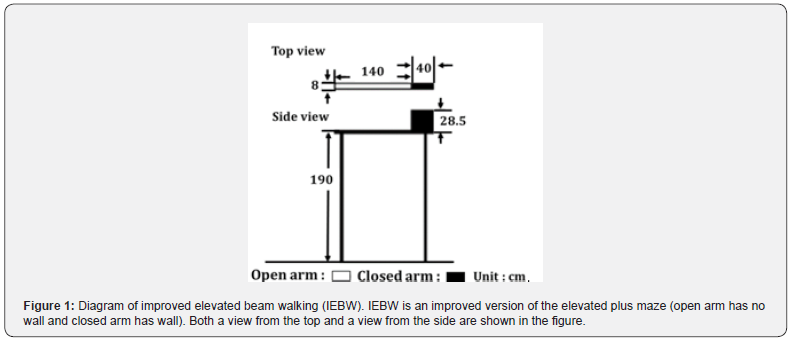
Experimental Methods
Experimental Process
After one-week preliminary breeding, the classified uneasiness and high sensitivity rats were operated with an installation of a living body electric potential transmitter to observe the ANS changes during this experiment period at all times. One-week post-operation, interventions 3 hours a day were carried out. After 14 times of continuous intervention, an opening field-test (OFT) was performed. And at the sampling, we had the small intestine extracted (Figure 2A). In addition, except the intervention period, all the rats’ activities such as intake of eating or drinking at the breeding environment were recorded with a video camera (Figure 2B).
Autonomic Nerve Activity
The experimental rats were given local anesthetics (ropivacaine hydrochloride hydrate, surface anesthesia, drops into the incision site) and general anesthetics (sodium pentobarbital, 40 mg/kg, i.e.). A wireless telemeter (TR50BB; KAHA sciences Ltd.) was performed to implant the device in the abdominal cavity, and intramuscular injections of antibiotics (imipenem hydrate and cilastatin sodium, 8.3 mg/kg) were administered to prevent postoperative infection. A 7-day postoperative recovery period was allowed before this experiment was initiated. HRV data were recorded over time by a biopotential transmitter attached to the rats during the experiment, and cardiac autonomic activity was assessed by spectral analysis of R-R interval variability using a Lab Chart software (Bioresearch center, Japan). The LF and HF components were expressed in standardized units (LFnu and HFnu), where HFnu indicates cardiac parasympathetic activity and LFnu indicates sympathetic activity with parasympathetic modulation.
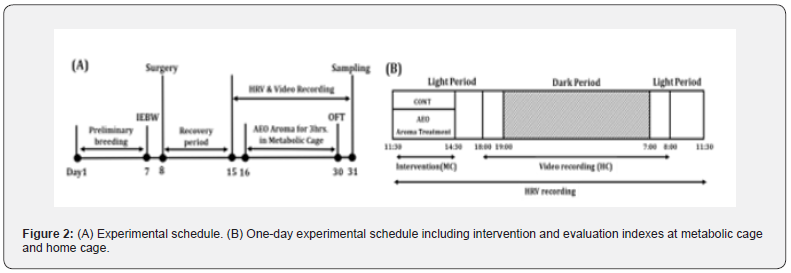
Intervention Method and Measurement in Metabolic Cage
Eleven anxiety-sensitive rats were randomly divided into a notreatment group (CONT, n=6) and a scent treatment group (AEO, n=5). The intervention was performed daily for 3 hours during a 2-week period in a metabolic cage (MC) to measure respiratory quotient and locomotor activity. In contrast with the CONT group being untreated and only placed at MC for 3 hours, for the scent treatment of AEO group, 100% pure wormwood essential oil (Artemisia Essential Oil, Kohakudo) extracted from leaves and stems and collected by steam distillation, mixed with odorless oily Triethyl Citrate (Tokyo Chemical Industry Co., Ltd.) was placed in a small cage connected to the metabolic cage. The metabolic cage was connected to a vacuum pump that sequentially sucked air from the small cages at a flow rate of 2.04L/min to deliver fresh aroma and air to prevent acclimation. In addition, during the intervention, the evaluation of energy metabolism including the indexes of respiratory quotient, oxygen consumption and quantity of motion were also measured through a metabolic measurement system for small animals (MK-5000RQ, Muromachi machine Inc.), which was tethered to the metabolic cage (Figure 3).

Behavior in home cage and OFT
In addition to the assessment of autonomic activity, the rats’ behavior in the home cage (HC) other than a 3-hour treatment period was recorded by video camera from 18:00 until 8:00 of the next day. The time zones of 18:00-19:00, 19:00-7:00, and 7:00-8:00 were designated as light period 1 (Light1), dark period (Dark), and light period 2 (Light2), respectively, conforming to the 12-h light/dark cycle in animal room, respectively. Also, aiming at finding changes of rats’ behavior, the amount of activating or resting time of rats during each period were added and calculated. An open-field test (OFT) devised by Broadhurst [6], is often used to evaluate anxiety states in rodents under novel environments, observing exploratory behaviors such as spontaneous locomotion and time spent in a central area without walls [7]. In this study, the measurement was conducted after 2 weeks of aroma conversation using a circular open-field apparatus (OF-25R, diameter 75 cm, wall height 40 cm, Muromachi Machinery, Japan) shown in (Figure 4), which is composed of 3 compartments, A-Zone at the periphery, B-Zone in the middle, and C-Zone in the center.
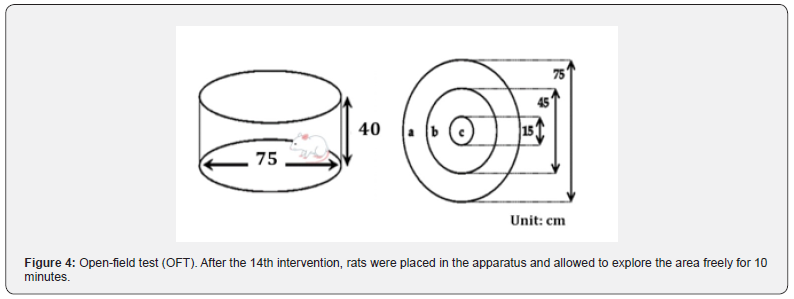
The rats were placed in the apparatus and allowed to explore freely for 10 minutes, the activities of the rats including spontaneous movements and searching activities to each zone and the time spent there in the apparatus was recorded by a video camera, and then their behaviors were analyzed by ANY-maze™ (Stoelting Co., Ltd.). The longer they stayed in the A-Zone, was more passive and anxious; and the longer they stayed in B-Zone, the more motivated and active they were, and the more courageous and active they were when entering C-Zone. Furthermore, to measure psychological changes over time in more detail, the 10-minute exploratory behaviors were analyzed by dividing three sections into a one-third (beginning of 1/3, middle 1/3, and last 1/3). Meanwhile, the autonomic nervous system (ANS) activities were also evaluated concurrently (Figure 4).
Elasticity Measurement of Small Intestine
After 2 weeks of AEO conversion and OFT measurement, the rats were killed, and the jejunum and ileum of the small intestine were removed. It was then measured for elasticity using a loaddisplacement measuring unit (KE-FSA-05K2-5N, IMADA, Japan) by means of tension and the time before the bowels being teared.
Statistics Analysis
All results are expressed as mean ± SE for each group. Homogeneity of variances was checked using the Levene’s test by SPSS statistics 28 (IBM, Tokyo, Japan), And the following comparison between two groups was performed by pair t-test. P values less than 0.05 were significant.
Results
Autonomic Nerve Activity
Before the study, the mean autonomic nerve activity in MC, a substantial difference between CONT and AEO groups of LFnu and HFnu were not seen. But at the time of the 14th fragrance intervention, a remarkable 19% decrease of LFnu was considered in AEO group than the CONT group (Figure 5-A). In HC, where everyday actions were observed except for 3 hours of fragrance revelation time. After the last measure, LFnu decreases and the following increase were seen during the light and dark periods, respectively. Even a significant difference of LFnu was not shown between the two groups, but a remarkable drop of LFnu and sthenia of HFnu were seen in AEO group when compared with CONT group at light2 period (p=0.058) (Figure 5B).
10-minute average autonomic nerve activities based on search actions under the novel environment by OFT was regularly used to evaluate rats’ uneasy states. From detailed analysis of ANS through the divided three portions of 10 minutes, a tendency of LFnu drop and HFnu rise was shown in each section after 14th intervention, especially at the beginning of 1/3 period, AEO rats showed a significant decrease of LFnu than CONT rats (Figure 5C).
Behaviors In Home Cage
In addition to the actions of rats in metabolic cage by the fragrance revelation, rest state such as sleeping or keeping still with open eyes, as well as activity state like feeding behavior, standing or personal grooming in home cage were observed. After the continuous 14 interventions, rest, and activity quantities during the period of 12 hours (18:00~8:00) in home cage were calculated. At light period, which means the rest time to rats, two groups showed almost the same aspects (data not shown), but at the dark period, which indicates the activity time to rats, AEO rats showed a large decrease of rest time together with an increase of active time (p=0.054) (Figure 6).
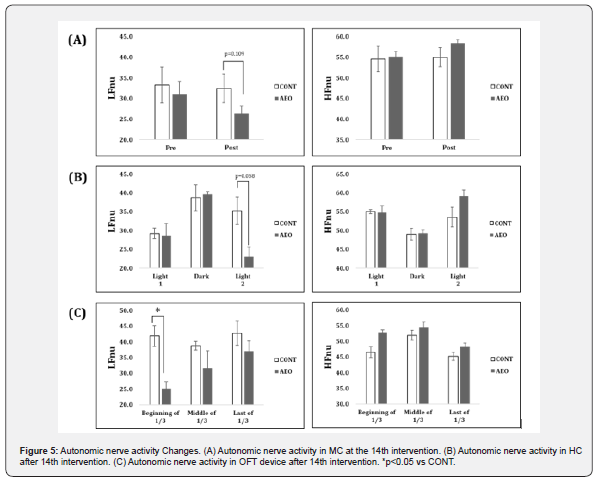
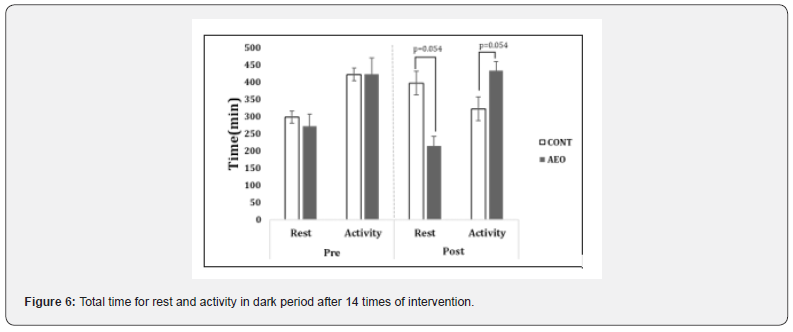

Actions in OFT
In the open field device, activities were recorded with a video camera to evaluate self-motion in each division and the sojourn time there, which indicates an index of the uneasy state of rats. For the sojourn time, moving time and the number of times to enter into each zone, were not significantly different between the two groups. However, even though there was no difference in total movement time compared with the CONT group, both a longer trend to enter into the intercentral part of B-zone and the sojourn time there was seen in AEO group, which might possibly represent these rats’ some positive and active behaviors with a calm state than CONT rats, because the latter rats were shown more entries into each zone but shorter time where they stayed there (Figure 7).
Changes of Respiratory Quotient (RQ) and Oxygen Consumption (VO2)
To examine whether the continuous fragrance revelation has influence on energy consumption, we measured respiratory quotient and oxygen consumption at the time of the last intervention in metabolic cage. Concurrently, momentum changes such as eating and grooming actions were also observed, at the last time of intervention, CONT and AEO groups showed -6.8% and -55.8% decreased respectively when compared with pre-study. In accord with the actions in the metabolic cage, AEO (RQ: 0.83, VO2: 6.85) showed a significant decrease in both RQ and VO2 than CONT (RQ: 0.85, VO2: 7.81), whereas there was not a difference before the experiment (Figure 8).

Small Intestinal Elasticity and Tension
It is known that gastrointestinal motility has a close relation to autonomic nerve activity, so to observe an influence that fragrance revelation gave to the bowels on uneasiness high sensitivity rats, the small intestinal elasticity was measured. Figure 9 showed the result of small intestine’s state. The tension of jejunum and ileum as well as the time before ileum being sharp, which relates to the exercise of bowels closely, was not shown significantly between the two groups, but the tendency that AEO group was throughout higher than CONT rats, together with a significant longer time was found in AEO group before the ileum was split. In addition, the parameters mentioned above were also accorded with the feelings and views of us when we took out the small intestine at sampling.
Discussion
Essential oil has been used as one of the nature cures for a long ago. Food fragrance or soap, laundry detergent is widely used as well as aromatherapy. In late years, the essential oils exerted anxiolytic-like effect, as such oils including lavender essential oil reveal stronger potential for development of new treatments for anxiety disorders [8-10]. Therefore, as a new cure for anxiety disorder that there are few side effects, the interest in aroma is receiving more study. The mugwort is used as Chinese medicine and raw materials of the moxibustion from the ancient times, has been extensively investigated and shows promising activities such like the effects of depression and uneasy reduction or insomnia by the clinical practice of acupuncture [11-13].
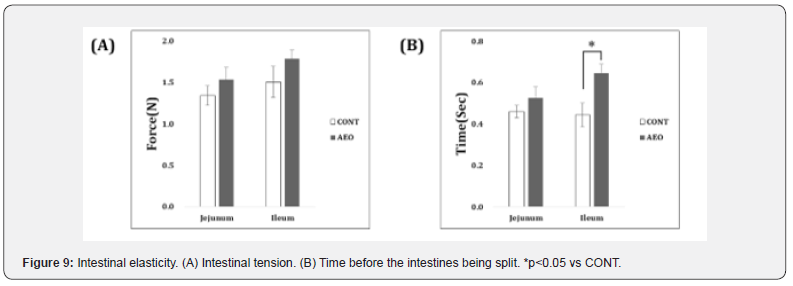
However, the current literature remains sparse for studies on the inhalation of the moxa odor to potential anxiolytic-like effects or stress relief up to this point. In this present study, we distinguished the rats’ characters by IEBW and selected the hypersensitive uneasiness model rats, which also purposes to limit the variations of data as possible even with a small sample size. It is known that sympathetic nerve becomes dominant in the state of hyperstrain by stress and decreased in a relaxed state. Autonomic nervous system controls a neuromodulation function to keep the constancy of the living body corresponding to environmental stress and plays an important role in reflex responses to blood pressure, pulse, the exercise of stomach and intestines et al. [14]. In addition, mental diseases such as adjustment disorders with excessive reactions to social life stress that cause maladaptive states, are classified as stress-related obstacle [15].
At the 14th intervention time, a calm tendency of LFnu drop and HFnu ascent of AEO rats were seen in our present study. For the impetus of rats such as actions of food intake or standing in MC, a large decrease in AEO (-55.8%) than CONT group (-6.8%) when compared with baseline was accorded with these autonomic nervous activities above as well. Furthermore, in the OFT after continuous fragrance measures, AEO showed all drops for ten minutes and a significant decrease in LFnu and a rise of HFnu during the beginning of 1/3 period. These results suggested that the fragrance measures of the mugwort might possibly bring relaxation by controlling sympathetic nerve activities under the novel environment, where the rats would more easily feel some stress load. In addition, it is known that anxiety disorder and depression are also annoyed with some symptoms like the loss of joy and interests, decrease in activities, as well as anorexia and its caused weight reduction.
During the dark period (activity time for rats) in HC, the action time of AEO rats tended to be longer than the CONT. In addition, the AEO group indicated a will to enter the intermediate zone with less comings and goings through each domain, together with a longer-time tendency to stay in the B-Zone and activate there. It is reported that the rats prefer to spend in the central part of C-Zone or B-Zone around C than A regularly considered to have less fear and anxiety, and an improvement of searching will be full of curiosity contrarily under the novel environment likewise [16]. Therefore, besides the relaxation action previously described at the intervention time of AEO, the effect in raising the will of the spontaneous activity after that might also be expected. It is suggested that the effect of mug wort fragrance was not only instantaneous but also continuous.
Since behavior pattern presents a reverse correlation between nontubal and diurnal animals. Namely, rats are active at night eating lively during the dark period whereas people do in the day [17]. Narusawa’s study on autonomic nerve activities for dyscoimesis at the sleep stage showed that sympathetic nerve tended to be high in the early period of falling sleep and it possibly correlates the difficulty of sleep that the patient feels [18]. In addition, Kobayashi reported that night awakening during sleep was characterized by predominance of the sympathetic system including increased heart rate for patients with post-traumatic stress disorder (PTSD), which was especially observed at the early period of sleep due to the adjustment disorder of the autonomic nerve and related to the shallow sleep of the patient as well [19]. In our experiment, CONT group presented obviously increased LFnu in the early period of the falling sleep, it resembled the results of the researchers stated above. In addition, according to the action evaluation at the early period of sleep (Light2 period) by the video, AEO group showed a shorter time to fall into resting state and an early trend to fall asleep. These findings seemed to show AEO’s sleep conduction effects in uneasiness and high sensitivity rats, which might contribute to the improving effects for sleep disorder coexistent for a mental disease including uneasiness.
Respiratory quotient, also known as the respiratory ratio (RQ), is defined as the volume of carbon dioxide released over the volume of oxygen absorbed during respiration. It is a dimensionless number used in a calculation for basal metabolic rate when estimated from carbon dioxide production to oxygen absorption [20]. Generally, it is thought that the ratio of sugar consumption is high near to 1.0 and lipid close to 0.7. Moreover, lipid is also known to burn during rest time, conversely sugar mainly when doing exercises [21]. In our study, AEO showed a higher RQ than CONT, it seemed to show that AEO group had many ratios of lipid metabolism relatively and tended to become a resting state. On the other hand, VO2 is known to increase along with the exercise strength including momentum [22]. The results show that AEO’s lower VO2 (6.85) means a decreased exercise strength than CONT rats (7.81), in conjunction with the decreased momentum found at the 14th intervention, it seemed to present AEO rats got closer to energy metabolism at rest. As a result of the above, it seemed to suggest that the sustained intervention of the mugwort fragrance could enhance rest even under the stress environment.
Psychosomatic disorders caused by mental stress always produce some kinds of physical diseases such as stomach duodenal ulcer or sleep disturbance. Among the kinds of therapies, spasmolytic is often used for a digestive organ disease, but resulted from its use restrictions due to side effects, alternative therapies including aroma have been developed by researchers [23,24]. Jejunum and ileum are generally used for parameters of the related studies on spasmolysis action. Aishah reported that inflammatory bowel disease in conjunction with the stress resulted in constrictive drop of the bowels [25]. Azuma demonstrated a drop of the retraction of ileum and colon in stress mice [26,27]. In addition, the elasticity of bowels is related to peristalsis, and its drop would influence bowels’ motor functions [28]. Our findings that AEO group was significantly longer in the time of small intestine being sharp along with its higher tension to high sensitivity and uneasiness rates was also agreed with Azuma’s results. Against the controlled shrinkage of bowels due to stress in CONT group, there were many scenes where the parasympathetic nerve became dominant in AEO rats. It seems to suggest that the fragrance measure would improve the elasticity of jejunum and the ileum and dependently have the possibility to promote enteric peristalsis.
On the other hand, it is known that both elasticities drop of the intestinal wall and hypofunction of large intestine regularly occur the abnormality of the bowel movement [29], the elastic improvement of the bowels would help to raise the function of shrinkage and movement of bowels. Thus, it might also be expected that hypersensitive colon syndrome characterized with constipation and diarrhea accompanied with abdominal pain to be relaxed by this measure. It is well known that after the odorous information being handed down to the limbic system through a nerve synapse, hippocampus charging for the memory information and amygdala controlling the feelings of likes or dislikes are reminded. In another route to hypothalamus, it is known to act on the autonomic nervous system or endocrine system [30]. In our experiment, it is supposed that the continuous smell is conveyed to hippocampus, where environmental information as well as the memory of smell are formed, which might contribute to the physiological effects of aroma mentioned above [31].
Kunihiro reported mug wort’s calming effects and the possibility that the ingredient of 1,8-cineole causing sedation [32]. Besides, it is reported that inhalation of 1,8-cineole to a mouse has sedation, antianxiety and antidepressant actions. In addition, Jia found behavioral changes that tend to keep resting state in mice under inhaling during the combustion because 1,8-cineole existed at high density in moxibustion smoke [33]. These results also correspond to the evidence of our clinical practice that the relaxed action to patients induced by moxibustion treatment. There is a difference in the content of the ingredient that depends on the season of the crop and locality [34-36]. That mugwort harvested in Japan is reported to include 1,8-cineole, borneol, β- thujone and camphor et al. According to precedent studies, it is thought that the component of 1,8-cineole greatly contributes to the anxiety action to rats. However, because other ingredients such as borneol or β-thujone’s uneasy improving effects were reported as well, thus their congruent actions might not be denied and would be possibly involved and responsible for the total improvements [37- 39].
Few animals were used in this experiment due to the limited number of bioelectric potential transmitters, which is thought to lead to a big unevenness of the data. Therefore, the tendency towards improvements of ANS and sleep conduction effects should be reproved in the future experiment through using more rats. And furthermore, to clarify the relationship between metabolism and intestinal function, pathology of the bowels should be added as well as the changes of body weight and bait intake.
References
- COVID-19 Mental Disorders Collaborators. Damian F Santomauro et al. (2021) Global prevalence and burden of depressive and anxiety disorders in 204 countries and territories in 2020 due to the COVID-19 pandemic. The Lancet. 398: 1700-1712.
- Japanese Association of Training Schools for Mental Health Workers (2016) New training course for mental health workers 1: Mental Disorders and Their Treatment, 2nd edn. Chuohoki Publishing Co. Tokyo, Japan. pp167-169.
- Clarke DM, Currie KC (2009) Depression, anxiety and their relationship with chronic disease: a review of the epidemiology, risk and treatment evidence. Medical Journal of Australia 190(S7): 54-60.
- Dougnon G, Ito M (2020) Inhalation administration of the bicyclic ethers 1,8 and 1,4-cineole prevent anxiety and depressive-like behaviours in mice. Molecules 25(8): 1884.
- Miyazaki S, Oikawa H, Takekoshi H, Hoshizaki M, Ogata M, et al (2018) Anxiolytic effects of Acanthopanax senticosus HARMS occur via regulation of autonomic function and activate hippocampal BDNF-TrkB signaling. Molecules 24(1): 132.
- Yamaguchi T, Yoshioka M (2007) Assessing methods of anxiety-related behaviors. Folia Pharmacol. Jpn. 130: 105-111.
- Broadhurst PL (1969) Psychogenetics of emotionality in the rat. Ann N Y Acad Sci 159(3): 806-824.
- De Sousa DP, De Almeida Soares Hocayen P, Andrade LN, Andreatini R (2015) A systematic review of the anxiolytic-like effects of essential oils in animal models. Molecules. 20: 18620-18660.
- Sanchez-Vidana DI, Ngai SP, He W, Chow JK, Lau BW, et al. (2017) The effectiveness of aromatherapy for depressive symptoms: a systematic review. Hindawi. Evid Based Complement Alternat Med 2017: 5869315.
- Kim M, Nam ES, Lee Y, Kang HJ (2021) Effects of lavender on anxiety, depression, and physiological parameters: systematic review and meta-analysis. Asian Nursing Research. 15(5): 279-290.
- Wei D, Zhao N, Xie L, Huang B, Zhuang Z, et al. (2020) Electroacupuncture and moxibustion improved anxiety behavior in DSS-induced colitis mice. Gastroenterol Res Pract 2019: 2345890.
- Koul B, Taak P, Kumar A, Khatri T, Sanyal I (2017) The artemisia genus: A review on traditional uses, phytochemical constituents, pharmacological properties and germplasm conservation. J Glycomics Lipidomics 7: 1-7.
- Sun YJ, Yuan JM, Yang ZM (2016) Effectiveness and safety of moxibustion for primary insomnia: a systematic review and meta-analysis. BMC Complement Altern Med 16: 217.v
- Friedman EM, Irwin MR (1997) Modulation of immune cell function by the autonomic nervous system. Pharmacol Ther. 74(1): 27-38.
- Toru M, Nakane Y, Komiyama M, Okazaki Y, Okubo Y (2011) ICD-10 mental and behavioral disorders -Clinical descriptions and diagnostic guidelines. Igaku Shoin, Tokyo, Japan. 129-130.
- Royce JR (1997) On the construct validity of open-field measures. Pharmacol 8(6): 477-496.
- Sato T (1986) Basics of Animal Experiments. Nishimura Shoten Niigata: p24-25.
- Narisawa H, Takahashi T, Yagi T, Chiba S, Sasaki M (2019) Features of electroencephalographic Changes and autonomic nervous activity during sleep onset period of patients with difficulty falling asleep. Biofeedback Research 46(1): 11-17.
- Kobayashi I, Joseph L, Kimberly B, Thomas AM (2016) The impact of posttraumatic stress disorder versus resilience on nocturnal autonomic nervous system activity as functions of sleep stage and time of sleep. Physiology Behavior 164: 11-18.
- Patel H, Kerndt CC, Bhardwaj A (2023) Physiology, respiratory quotient. In: StatPearls [Internet], StatPearls Publishing, Treasure Island (FL): p1-11.
- Maruyama H (1987) Motion physiology for physical therapy - Oxygen consumption and physical therapy. Motion Physiology 2(3): 147-158.
- Ito R (2021) Sports and Pulmonary Function. J Nihon Univ Med Ass 80(1): 21-25.
- Annahazi A, Roka R, Rosztoczy A, Wittmann T (2014) Role of antispasmodics in the treatment of irritable bowel syndrome. World J Gastroenterol 20(20): 6031-6043.
- Simona CH, Oliviu V, Lucia MR, Cristina M, Cristina AI, et al. (2019) Antispasmodic effect of essential oils and their constituents. Molecules 24(9): 1-29.
- Aishah AJ, Islam K, Mabayoje AO (2008) Role of Ca2+-sensitization in attenuated carbachol-induced contraction of the colon in a rat model of colitis. Eur J Pharmacol 579(1-3): 365-373.
- Azuma YT, Suzuki S, Nishiyama K, Yamaguchi T (2021) Gastrointestinal motility modulation by stress is associated with reduced smooth muscle contraction through specific transient receptor potential channel. The Journal of Veterinary Medical Science 83(4): 622-629.
- Ono N, Suzuki S, Kawada K, Yamaguchi T, Azuma YT (2022) Stress decreases contraction of the colon, and the effects of stress are different among the regions of the colon. J Vet Med Sci 84(8): 1061-1064.
- Hosoda S, Bamba T, Nakago S, Fujiyama Y, Senda S (2016) Age-Related Changes in the Gastrointestinal Tract. Int J Pharm 512(2): 382-395.
- Baba T (2001) Colon functions in the elderly. Journal of Geriatric Gastroenterology 13(1): 37-40.
- Touhara K (2015) Reception Mechanisms of Olfactory smell, Nippon jibi inkoka gakkai kaiho 118(8): 1072-1075.
- Iwaki I (2010) Illustrated Dictionary of Aromatherapy. Takahashi Shoten, Tokyo: p. 38-39.
- Kunihiro K, Myoda T, Tajima N, Gotoh K, Kaneshima T, et al (2017) Volatile components of the essential oil of artemisia montana and their sedative effects. Journal of Oleo Science 66(8): 843-849.
- Jia Y, Xiaojun Z, Ran J, Li H, Lue H, et al. (2016) Effect of moxa smoke produced during combustion of Aiye (Folium ArtemisiaeArgyi) on behavioral changes in mice inhaling the smoke. J Tradit Chin Med 36(6): 805-811.
- Rita BA, Flamini G, Morgenni F, Isacchi B, Francesco VF (2008) GC MS Analysis of the volatile constituents of essential oil and aromatic waters of artemisia annua L. at different developmental stages. Natural Product Communications 3(12): 2075-2078.
- Ekiert H, Pajor J, Rzepiela A, Slesak H, Szopa A, et al. (2020) Significance of artemisia vulgaris L. (common mugwort) in the history of medicine and its possible contemporary applications substantiated by phytochemical and pharmacological studies. Molecules 25(19): 4415.
- Abad JM, Bedoya LM, Apaza L, Bermejo P (2012) The artemisia L. genus: a review of bioactive essential oils. Molecules 17(3): 2542-2566.
- Cao B, Ni HY, Li J, Zhou Y, Bian XL, et al. (2018) (+)-Borneol suppresses conditioned fear recall and anxiety-like behaviors in mice. Biochemical and Biophysical Research Communications 495(2): 1588-1593.
- Rivera EM, Cid MP, Zunino P, Baiardi G, Salvatierra NA (2014) Central α- and β-thujone: Similar anxiogenic-like effects and differential modulation on GABAA receptors in neonatal chicks. Brain Research 1555: 28-35.
- Mora S, Diaz Veliz G, Millan R, Lunge strass H, Quiros S (2005) Anxiolytic and antidepressant-like effects of the hydroalcoholic extract from Aloysia polystachya in rats. Pharmacol Biochem Behav 82(2): 373-378.






























